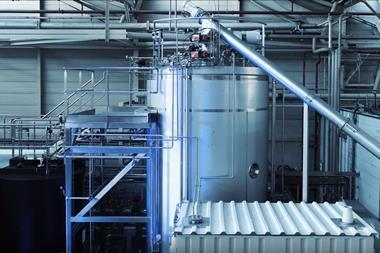Everyday plastic food packaging contains chemicals that can disrupt the working of human cells, two new studies from a Norwegian group reveal. The effects include interfering with cell receptors that are crucial for hormonal and metabolic control, as well as our body clock.
The Norwegian lab tested chemicals from plastic items purchased in five countries – US, Germany, the UK, South Korea and Norway – against four cell receptors.1 Non-target high-resolution mass spectrometry and reporter gene assays revealed that 18 out of 36 plastics contain chemicals that activate estrogen receptors and 14 contain compounds that block androgen receptors. ‘There are thousands of unique chemicals present in plastics and they are disrupting endocrine and metabolic receptors,’ says Molly McPartland, a PhD candidate in the lab of Martin Wagner at the Norwegian University of Science and Technology.
Plastics consist of a polymer backbone with chemicals such as plasticisers, solvents and catalysts added during manufacture. Impurities and degradation products may also be present. These compounds can leach out into contact materials, including food, which has worried food safety researchers.
McPartland and her colleagues used methanol to extract chemicals from 36 food-contact plastic items, including a coffee cup, yoghurt lid, cling film and a water bottle. The number of chemicals isolated varied across the seven plastics in the study. Numbers ranged from 616 in high-density polyethylene, 2284 in polystyrene and 12,683 in polyvinyl chloride (PVC).
Chemicals from 23 of the 36 packaging items were found to disrupt a receptor that controls fat cell development and all but three products trigger the pregnane X receptor, which plays a role in cellular detox, as well as energy balance and inflammation. The mixtures obtained from the plastics also triggered two internal cell receptors.
‘These mechanistic studies show literally thousands of chemical signatures coming out of these common food packaging plastics and hitting receptors that mediate important elements of biology in the human population, specifically metabolic issues and obesity,’ says Robert Zoeller, a biologist at the University of Massachusetts Amherst.
In a second investigation, the group tested many of the same food-packaging items, but this time for their influence on G protein-coupled receptors (GPCRs), the target for most drugs.2 ‘These receptors are super interesting,’ says McPartland. ‘They’re basically like the signalling towers on the outside of our cells, receiving and then transmitting signals inside the cell.’
The team relied on a pharmacological technique used in drug discovery to screen 126 different GPCRs to see if they were activated by the chemical mixtures from the plastics. Eleven were. The strongest hits were against the melatonin receptor 1 – which helps control our body clock – and adenosine receptor 1 – which is a ubiquitous receptor involved in cellular metabolism, energy consumption and nerve signalling. Chemicals derived from PVC and polyurethane had the most powerful effects on melatonin and adenosine receptors.
‘Frankly this second paper frightens me,’ says Zoeller. ‘Every cell literally has hundreds of G protein-coupled receptors. Cells interact with each other through ligands for these receptors. They are enormously important for physiology. Without them, vertebrates wouldn’t exist, mammals wouldn’t exist, humanity wouldn’t exist.’
The Norwegian researchers call for simpler plastics. It is possible to make plastic products with far fewer additives, they say, something governments could legislate for.
‘We know very little about the composition of plastic products or how they interact with biological systems – whether they are hazardous or toxic,’ says Helene Wiesinger, a chemist at ETH Zurich in Switzerland. ‘It would help to have more transparency. We could do more targeted testing and choose the safest alternatives for sensitive products like food packaging or medical items.’
Wiesinger previously investigated new PVC flooring on the Swiss market and found enormous variability in products that looked quite similar, as well as some banned chemicals that likely originated from the use of recycled PVC. Her research also identified more than 10,000 intentionally added monomers, additives and processing aids.
‘We’re a good 30 years into an increasing recognition that synthetic chemicals in plastic are affecting human biology,’ says Zoeller. ‘These fossil fuel derivatives are produced by organic chemists who never had a toxicology course and who don’t think in terms of chemicals that might hit biological receptors – but they should.’
References
1 S Stevens et al, Env. Sci. Technol., 2024, DOI: 10.1021/acs.est.3c08250
2 M McPartland et al, Env. Sci. Technol., 2024, DOI: 10.1021/acs.est.3c08392


















No comments yet